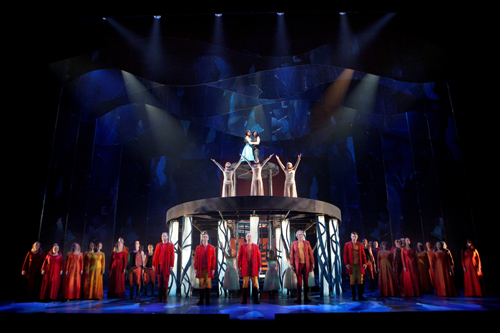 Sweden W.A. Mozart, The Magic Flute: Henrik Schaefer (conductor), Gothenburg Opera 12.5.2012 (NS)
Sweden W.A. Mozart, The Magic Flute: Henrik Schaefer (conductor), Gothenburg Opera 12.5.2012 (NS)
Production: Gothenburg Opera (GöteborgsOperan)
Director: Rickard Bergqvist
Set and costume design: Tomas Sjöstedt
Light design: Joakim Brink
Choreography: Camilla Ekelöf
Translation and adaptation of libretto: Rickard Bergqvist
Cast:
Sarastro: Michael Schmidberger
Tamino: Mathias Zachariassen
Speaker: Marco Stella
Queen of the Night: Karolina Andersson
Pamina, her daughter: Eva-Lotta Ohlsson
First Lady: Mia Karlsson
Second Lady: Carolina Sandgren
Third Lady: Erika Sax
Papageno: Markus Schwartz
Papagena: Cecilia Vallinder
Monostatos: Mattias Ermedahl
Priest/First soldier: Ingemar Andersson
Second soldier: Peter Loguin
Three Boys: Thérèse Andersson, Malena Tuvung, Anna Werner

Rickard Bergqvist’s production of Mozart’s The Magic Flute enchanted Gothenburg’s opera audience at its premiere in 2009 and has just begun a revival. The plot is played out as a dream in Tamino’s head, without any specific time or place. The director’s interpretation plays down the Masonic symbolism but also adds nuance: the Queen of the Night is not simply bad and Sarastro not simply good either. Instead their mutual loathing and battle to control Pamina is overcome by Tamino and Pamina’s love. The final scene is wholly their triumph, not Sarastro’s.
The production is a visual delight in every scene: from the hedonistic picnic during the overture (the real world which Tamino leaves behind until the very end of the opera) to the dark blues of the Queen of the Night’s scenes and the flame-coloured clothes of Sarastro’s acolytes. Camilla Ekelöf’s choreography was even better. Many scenes involved dancers, and Sarastro’s religion involved singing, dancing and (in the March of the Priests) a sort of contemplative exercise that could have been inspired by tai chi. The result was imaginative and a joy to watch.
If the singing was not always at the same level it was partly the result of first-night nerves; Papageno’s (Markus Schwartz) early entry in his duet with Pamina was a one-off mistake. Likewise, Mathias Zachariassen’s Tamino sometimes had pitch problems in the first act but otherwise sang sensitively and acted out Tamino’s journey from certainty to confusion to love very convincingly. Unfortunately, Michael Schmidberger’s lower register was too underpowered, leaving his Sarastro rather lacking in pondus.
Karolina Andersson (previously reviewed by your correspondent as the Governess in Britten’s The Turn of the Screw) was an excellent Queen of the Night. She captured her vanity and imperiousness perfectly and sang both of her fiendishly difficult arias without a wobble. She was ably assisted by three rather seductive Ladies (Mia Karlsson, Carolina Sandgren and Erika Sax).
The opera’s other trio – the Three Boys – were women rather than boys, but in an inspired decision by Mr Bergqvist they were all musical artists rather than opera singers. Thus their voices were boyish in tone but never drowned out by the orchestra or other soloists. They also danced beautifully.
Eva-Lotta Ohlsson took on the role of Pamina, having sung Papagena in the original production. Her performance was a highlight of the evening. Her singing was expressive and technically spot-on, and her acting and dialogue very well characterised. This Pamina is not a passive victim but an active, if emotional, woman. I look forward to seeing her in other roles in the future.
Ms Ohlsson’s replacement as Papagena, Cecilia Vallinder, was delightfully cheeky in her dialogue scenes with Papageno (helped by Mr Bergqvist’s excellent translation of the libretto to Swedish). A high point was her list of feminist expectations about marriage to Papageno, which was a nice counterpoint to the otherwise very patriarchal opinions expressed in the libretto (especially by Sarastro).
Markus Schwartz’s Papageno was wonderfully characterised. His dialogue part and his singing were delightful. Mr Schwartz’s interactions with Pamina and Tamino were also very well-judged, with a mixture of a puckish sense of humour and a dash of preening vanity. He even adopted some of the mannerisms of the birds he traps for a living.
As a musical experience the performance was only slightly uneven, mainly because of the underpowered Sarastro (in fairness it is a very difficult role to cast). Henrik Schaefer and the orchestra worked well with the soloists and the visual beauty of the production served to heighten the appreciation of Mozart’s heavenly music. I will enjoy seeing this production again.
Niklas Smith
